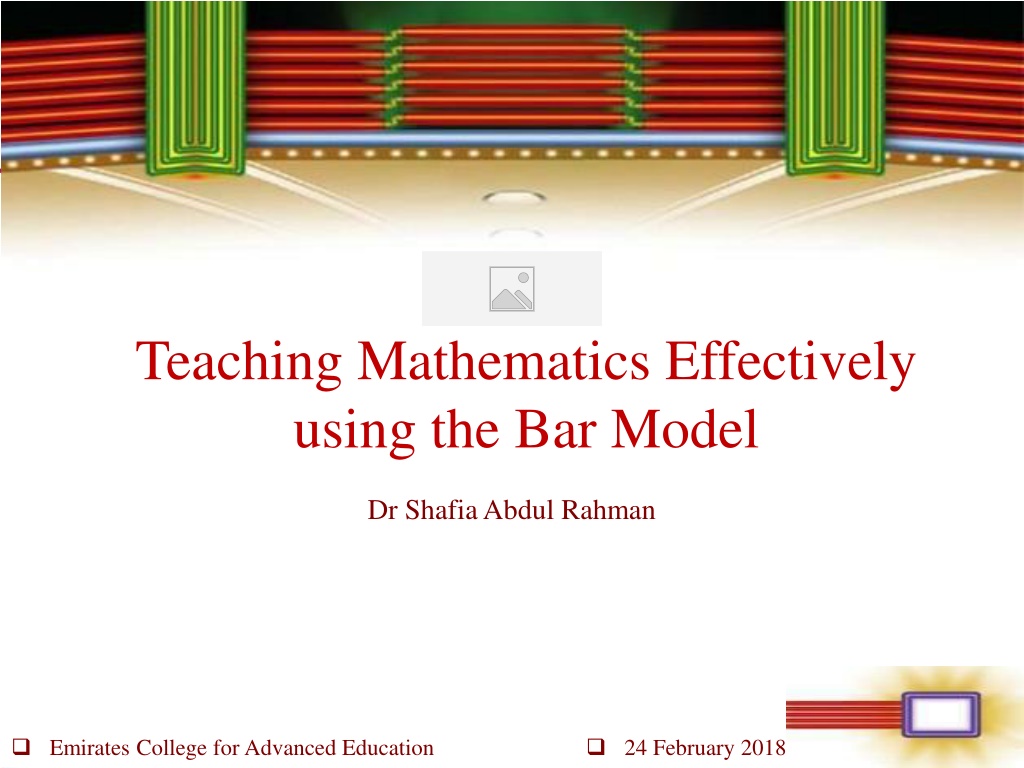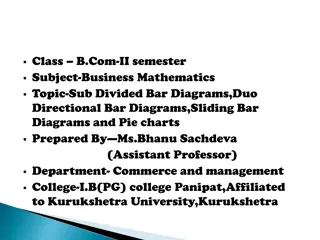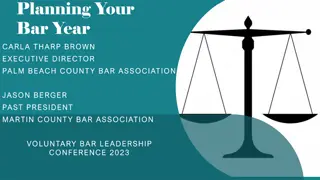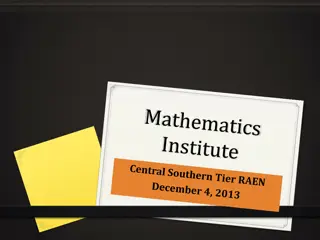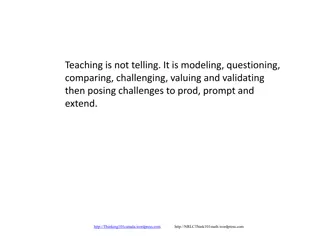Effective Mathematics Teaching with Bar Modeling
Explore the use of the bar model strategy for teaching mathematics effectively with real-life examples like "The Cookie Jar Problem" and "Grade 5 SATs Problem." Learn how bar modeling helps students visualize and solve math problems, promoting conceptual understanding and fostering mathematical processes. Discover the benefits of the Singapore-style bar model approach in enhancing problem-solving skills across various mathematical concepts.
Download Presentation

Please find below an Image/Link to download the presentation.
The content on the website is provided AS IS for your information and personal use only. It may not be sold, licensed, or shared on other websites without obtaining consent from the author. Download presentation by click this link. If you encounter any issues during the download, it is possible that the publisher has removed the file from their server.
E N D
Presentation Transcript
Teaching Mathematics Effectively using the Bar Model Dr Shafia Abdul Rahman Emirates College for Advanced Education 24 February 2018
The Cookie Jar Problem Mom had just filled a cookie jar when Ahmed, Khaled, Sultan, Amer and Lateefa went to bed. That night, Ahmed woke up and felt hungry. He ate half of the cookies. Later, Khaled got up and noticed the cookies. He thought they looked good, so he ate a third of what was left in the jar. A little later, Sultan then got up and ate a quarter of the remaining cookies. Then Amer woke up and took 2 cookies to munch on. When Lateefa looked at the jar, she saw that there were only four cookies left. How many cookies were there in the jar to begin with? 5 5
The Algebraic Solution Start with ? cookies After Ahmed you have: ? - (1/2) ?= (1/2) ? After Khaled you have: (1/2)?- (1/3)[?/2] = (2/3)(1/2)?= (1/3)? After Sultan you have: (1/3)? - (1/4)(1/3)?= (3/4)(1/3)?= (1/4)? After Amer you have (1/4)? 2 Lateefa saw 4 EQUATION: (1/4)? 2 = 4 (1/4)? = 6 ?= 24 cookies (the amount of cookies you had in the beginning) 6 6
Problem Success Rate Layla had AED240. She spent 5/8 of it. How much money did she have left? Success rate? - Use a particular representation which enables pupils to access the structure of the mathematics. 8 8
Bar Model 10 10
Bar Modelling Bar modelling is a Singapore-style of math model that allows pupils to draw and visualize mathematical concepts to solve problems. A versatile math model strategy that can be used across a wide range of concepts and topics. Gives pupils a powerful and adaptable strategy for solving increasingly difficult problems. Allows pupils to understand on a conceptual level what occurs when using complex formulas (for example, algebra). Draws on the concrete, pictorial, and abstract approach. 11 11
Model Drawing Model drawing (bar modeling) is a systematic method of representing word problems and number relationships. Students are taught to use rectangular bars to represent the relationship between known and unknown numerical quantities and to solve problems related to these quantities. The use of the rectangular bars and the identification of the unknown quantity with a question mark help students visualize the problem and know what operations to perform in short, viewing all problems from an algebraic perspective beginning in early elementary grade levels. 12 12
What makes model drawing so effective is the systematic and consistent way it is taught. Each grade level addresses distinct operations and number relationships addition and subtraction in second grade, multiplication and division in third, fractions and ratios in fourth and fifth so students can visualize and solve increasingly complex problems. Students learn to represent these objects with rectangles that enable them to see the number relationships, rather than focusing on the objects of the problems. Rectangles are used because they are easy to draw, divide, represent larger numbers, and display proportional relationships. 13 13
The bar model as a visual representation There are two main types of bar models: part-whole model comparison model to represent the quantities given in a word problem. This visual representation gives the students a better idea of how the known and unknown quantities in the word problem are related, making the understanding of word problems more accessible to students. 14 14
A Part-Whole Model The part-whole model can be used to solve problems involving addition and subtraction such as: given a part and a part, students add to find the whole; given the whole and a part, students subtract to find the other part. 15 15
A Comparison Model A comparison model where there are equal units indicates the use of either multiplication or division depending which quantity is given. 16 16
17 17
Example The total is given. To find the unknown: 4 units = 92 1 unit = 92 4 = 23 The quantity for one unit is given. To find the unknown, 1 unit = 15 3 units = 3 x 15 = 45 1 1 8 8
Using the Bar for Addition and Subtraction
Addition Aggregation There are 3 footballs in the red basket 2 footballs in the blue basket. How many footballs are there altogether? 20 20
Addition Augmentation Ali has 3 marbles. Ahmed gives Ali 1 more marble. How many marbles does Peter have now? Concrete Abstract 21 21
Subtraction Comparison Model Peter has 5 pencils and 3 erasers. How many more pencils than erasers does he have? 22 22
Moving to the abstract Peter has 5 pencils and 3 erasers. How many more pencils than erasers does he have? 23 23
Generalisation 24 24
Students are gradually led to the beginning of a concept of a variable and an unknown. These rectangles, which will become variable expressions in algebra, enable students to construct more abstract representations of problems as they continue in mathematics. Representing number relationships, comparisons, proportions, and changes becomes second nature as students do this from grade level to grade level. 25 25
Road to Algebra 2 2 6 6
In high school, students may be trying problems as complex as: A group of people pay AED720 for admission tickets to an amusement park. The price of an adult ticket is AED15, and a child ticket is AED8. There are 25 more adults than children. How many children are in the group? Or problems that involve changing quantities or situations that change: Jane had AED7 and her sister had AED2. Their parents gave them each an equal amount of money. Then Jane had twice as much money as her sister. How much money did their parents give each of them? 27 27
28 28
Problems to Solve 1. Seif has a bag of 64 marbles, his friend gives him 28 more, how many does he have now? 2. Kamal was running a 26 mile marathon, after 18 miles she felt very tired. How many more miles did she have to run? 29 29
Multiplication & Division Amal has 4 books. Wafa has five times as many books as Amal. How many books does Wafa have? 4 Amal 4 4 4 4 4 Wafa 30 30
Multiplication 1. Haleem has 9 times as many football cards as Sami. Together they have 150 cards. How many more cards does Haleem have than Sami? 2. The sum of 2 numbers is 60. One number is 9 times as big as the other. What is the bigger number? 3. The sum of 2 numbers is 64. One number is 7 times as big as the other. What is the smaller number? 31 31
Division 1. 108 Year 3 children are going on a field trip to the art museum. Each bus must carry 12 children. How many buses are needed? 2. Mr Smith had a piece of wood that measured 36 cm. He cut it into 6 equal pieces. How long was each piece? 32 32
Problems to Solve 1. The sum of two numbers is 36. The larger number is three times the smaller number. Find the two numbers. 2. Sam had 5 times as many marbles as Tom. If Sam gives 26 marbles to Tim, the two friends will have exactly the same amount. How many marbles do they have altogether? 33 33
Problems to Solve The sum of two numbers is 36. The larger number is three times the smaller number. Find the two numbers. 36 Student can visualize that the sum of the four bars is 36, and that 36 4 = 9 for the smaller number and 27 for the larger one. 34 34
Problems to Solve Sam had 5 times as many marbles as Tom. If Sam gives 26 marbles to Tim, the two friends will have exactly the same amount. How many marbles do they have altogether? 35 35
Gently lead the students from simple problems with easily manipulated numbers to more complex ones that require more arithmetic and multiple steps. Lisa had 1750 stamps. Maha had 480 fewer stamps than Lisa. Lisa gave some stamps to Maha. Now Maha has 3 times as many stamps as Lisa. How many stamps did Maha have at first? How many stamps does Lisa have now? 36 36
Lisa had 1750 stamps. Maha had 480 fewer stamps than Lisa. Lisa gave some stamps to Maha. Now Maha has 3 times as many stamps as Lisa. How many stamps did Maha have at first? How many stamps does Lisa have now? 1750 Lisa Maha 480 less Maha = 1750 480 = 1270 at first Maha + Lisa = 1270 + 1750 = 3020 total Lisa 755 3020 Maha 755 755 755 37 37
Solving Proportional Problems 1. Khulood has ten sweets, she eats half of them. How many does she have left? 2. Alia has 30 sweets, she eats 1/3 of them, how many does she have left? 3. Sara has 30 sweets, she eats 2/3 of them and gives half of remaining sweets to Amena. How many does she have left? 4. A dress costs AED32, it is reduced in price by 50%, how much does it cost now? 5. A dress costs AED32, it is reduced in price by 50%, how much does it cost now? 39 39
Solving Proportional Problems 1. A Super Mario Game costs AED45, it is reduced in price by 25%, how much does it cost now? 2. A computer game was reduced in a sale by 20%, it now costs AED40, what was the original price? 3. Laura had AED240. She spent 5/8 of it. How much money did she have left? 40 40
Revisiting the Problem 41 41
Fraction & Ratio Problems Part/whole problem: Amira spent 4/7 of her money on a pair of shoes. The shoes cost AED480. How much money did she have at first? Comparison problem: There are 3/5 as many boys as girls. If there are 75 girls, how many boys are there? ? Boys Girls 42 42 75
Fractions & Ratio Tim and Sally share marbles in the ratio of 2:3. If Sally has 36 marbles, how many are there altogether? 43 43
Solving Ratio Problems 1. A herbal skin remedy uses honey and yoghurt in the ratio 3 : 4. How much honey is needed to mix with 120 g of yoghurt? 2. A health bar sells desserts with chopped apricot and yoghurt in the ratio of 2 : 5. How much chopped apricot will be mixed with 150 g of yoghurt? 44 44
How would you solve this problem using Bar Model? 2 1. Khawla spent 20% of her money on a dress. She spent of the remainder on a book. She had AED72 left. How much money did she have to start with? 2. Mrs. Mirza made some tarts. She sold of them in the morning and of the remainder in the afternoon. If she sold 200 more tarts in the morning than in the afternoon, how many tarts did she make? 3. Najwa had a bag of marbles. She gave one-third of them to Reem, and then one-fourth of the remaining marbles to Jamal. Najwa then had 24 marbles left in the bag. How many marbles were in the bag to start with? 5 3 5 1 4 45 45
4. Jameela and Jehan had the same amount of money. Jameela gave AED1140 to a charity and Jehan gave AED580 to a different charity. In the end Jehan had 9 times as much money as Jameela. How much money did each girl have at first? 5 3 5. A rectangular tank is full of water. If liters of 9 6 4 2 water are poured into the tank, it will be full. What is 3 the capacity of the tank? 46 46
Fraction Problems Rosie baked 63 cookies. 3/7 of them were chocolate chip cookies and the rest were sugar cookies. How many sugar cookies did Rosie bake? 1 2 3 4 5 6 7 63 63 7 = 9 (one unit bar equals 9) 3 x 9 = 27 (chocolate chip cookies) 63 27 = 36 (sugarcookies) 63 7 = 9 (one unit bar equals 9) 9 x 4 = 36 (sugarcookies) 47 47
Fraction Problems 5/8 of the students in my class are boys. 1/5 of the boys have black hair. If 40 boys don t have black hair, how many students are in my class in all? 48 48
Fraction Problems 40% of the school students went to the museum for a field trip. 20% of students went to the zoo. 50% of the remaining students went to a farm. Only 60 students didn t have a field trip and stayed at school. How many students are there in this school? 49 49
Solution Step 1: Draw a unit bar and divide it into 10 equal parts 50% of remaining 60 in school 40% 20% Zoo Farm Museum Total students = ? 100% remaining students One unit bar = ? 1) 2) 60 / 2 = 30 30 x 10 = 300 Answer: There are 300 students in the school 50 50
